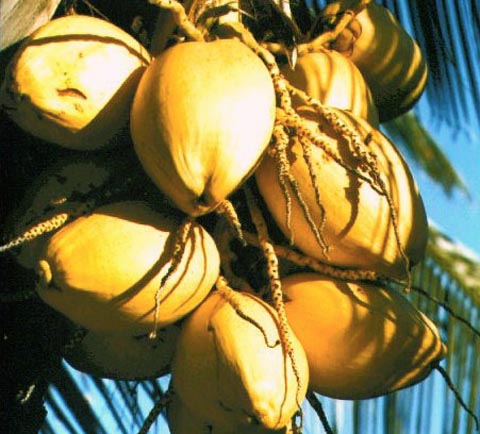Birds
and Plants of Kauai:
Niu: The Coconut Palm
There are three types of native plants: Endemic, Indigenous, and Polynesian. Endemic plants evolved in the Hawaiian Islands and do not grow naturally anywhere else. Indigenous plants got here naturally from other locations. They were originally brought by birds, wind, or the ocean before the first Polynesians arrived.
Polynesian plants are the canoe plants that the native Hawaiians brought with them. They were primarily food plants, or those that had practical or cultural uses.
Our featured plant is the Niu or Coconut Palm. It is one of the Canoe Plants brought to Hawaii by the Polynesians, and is thought to have originated in the western Pacific. The Niu was a valuable plant, and was used for food, thatching material, and fiber. It is the most common palm tree. It thrives on the coastline, in sandy, salty soil and grows well in the tropics near the equator. A coconut can travel thousands of miles on ocean waves and then germinate when washed
ashore. A stranded traveler could survive on coconut water and fish for quite some time.
Cocos Nucifer (the scientific name) can grow up to 100 feet tall. It has a cluster of fronds or leaves on the top. It is ringed along the trunk, where old fronds were previously attached. The trunk is often curved, and the tree is strong but flexible and bends to survive hurricane force winds.
The Niu blooms with a spathe, or spray of flowers. It takes fifteen months for the flowers to bear a mature fruit. A coconut tree will bear coconuts after seven years, and lives as long as a person, up to 100 years.
Traditionally, a coconut was planted when a Hawaiian child was born, with a he’e or octopus planted with it for fertilizer. When that person passed away, the tradition was to cut off the top of the palm tree as announcement and memorial.

Green coconuts are picked for their water. One coconut contains about a quart of water encased in a hard nut, then a fibrous husk. When the coconut is yellow or brown, it will drop from the tree. It still contains some water, and some soft white meat. The water and meat are mixed to make coconut milk, which is commonly used here in cooking. Haupia is thickened soft coconut meat cooked into a pudding. Coconut oil can be extracted from dried coconut meat.

The coconut flowers can be made into a drink, and also be fermented into wine. The fibrous husks of the coconut can be used to make waterproof rope, nets, mats, and brushes.
The leaves or fronds can also be woven into baskets or hats. Our friend Goro at Salt Pond Park often demonstrates this to rapt audiences at the beach. The palms are routinely trimmed in by the county to prevent accidents from falling coconuts. More people are killed by coconuts than sharks in Hawaii.
It is easy to plant a coconut to grow a new tree. First determine which side is the top (it will float top side up), then partially bury it top side up. It will germinate in about 5 months.
So, we hope you take advantage of this great Kauai plant, and “Wahi ka niu, or break open the coconut, and enjoy!
|




